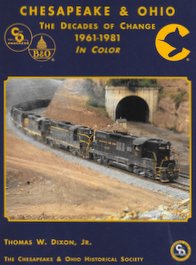By Thomas W. Dixon, Jr.
The Chesapeake & Ohio Historical Society 2017
ISBN 9780939487301
Review by Dan Bourque
 Thomas Dixon’s Chesapeake & Ohio, the Decades of Change is a surprisingly refreshing and unique book. If you’re a fan of the C&O in the coal fields, you doubtless have a few of the C&O Historical Society’s previous (and excellent) books by Mr. Dixon which primarily cover the coal fields in the heyday of steam. In this book, the author takes a different approach by focusing on two decades, the 1960s and 1970s, describing the incredible changes the railroad underwent to stay competitive in the increasingly volatile landscape of American industry and transportation after WWII. The result is a fascinating and educational journey about two of the most tumultuous decades for all American railroads as told through the lens of the C&O, one of the railroads who weathered this period fairly successfully when others did not.
Thomas Dixon’s Chesapeake & Ohio, the Decades of Change is a surprisingly refreshing and unique book. If you’re a fan of the C&O in the coal fields, you doubtless have a few of the C&O Historical Society’s previous (and excellent) books by Mr. Dixon which primarily cover the coal fields in the heyday of steam. In this book, the author takes a different approach by focusing on two decades, the 1960s and 1970s, describing the incredible changes the railroad underwent to stay competitive in the increasingly volatile landscape of American industry and transportation after WWII. The result is a fascinating and educational journey about two of the most tumultuous decades for all American railroads as told through the lens of the C&O, one of the railroads who weathered this period fairly successfully when others did not.
The C&O’s story is told in the form of chapters covering various aspects of railroad operations and the immense changes in each area including mergers, computers, labor, public relations, freight service, passenger service, motive power and coal traffic. The chapters vary significantly in length, but each contains a wealth of information in both words and excellent photos to illustrate. Those who love to study the coal fields need not worry–this book has plenty of coal field coverage along with many other fascinating and less known aspects of the railroad such as tug boats and car ferries. The last chapter is a lengthy photo album that follows the railroad from east to west and offers several dozen great photos from this era that range from well-known C&O landmarks to obscure pieces of the railroad. While the book isn’t about the Baltimore & Ohio, the book does a great job of explaining the tight link between the C&O and B&O during this era that eventually led to the creation of the Chessie System.
For the railroad buff and modeler, this book is incredibly valuable because it not only explains what changes occurred during this time frame, but it explains WHY those changes occurred. We may have observed the changes in locomotive fleets, car design and passenger operations in other books, but few really give a glimpse behind the scenes to understand the drivers behind the changes and innovation and the thoughts of the leaders that implemented them. For that reason, I found each chapter in this book fascinating and informative, even though I model other railroads. My only critique is this book would benefit from more thorough editing–there are some typos, grammatical errors and repetition that distract a bit while reading, but I certainly still highly recommend it. The photography alone (all color) is enough for anyone who likes the diesel-era C&O to buy this book, but the story it tells makes it a worthwhile read for anyone interested in ’60s and ’70s railroading in America.
Related Products:



